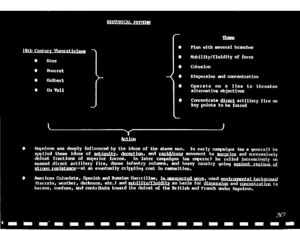Patterns of Conflict
| The works of |
| Works of John Boyd |
|---|
OODA WIKI Edition
Quantico Transcription
[40:00]Okay. Now, let’s move on then. I’m digressing too much here. Move closer to the present. 18th century theoreticians. Here we see these people, Saxe, Bourcet, Guibert, and Du Teil. And the theme associated: primary plan or several branches, primarily associated per se.
Mobility and fluidity of force. Cohesion, in other words, cohesion of force. And with these things then, they can play the so-called dispersion/concentration game. Napoleon played it very well, I might add. We’ll show you the way he played the dispersion/concentration game.
And this idea here, actually Liddell Hart brought it out, he brought it out by looking at Bourcet’s stuff, and also by watching or observing Sherman’s operations in the south. And so it operated on a line to threaten alternative objectives. He didn’t understand his own concept, I might add, point that out to you. [unintelligible] operating on a line to threaten alternative objectives. The idea being if you have alternative objectives, you operate between them, the guys doesn’t know what to do, so he tends to defend both. So that at the last moment, you have a large fraction of your forces going against him, I mean a large fraction of your force going against a small fraction of his, you get strength against weakness. In other words, you put the guy on the a horns of a dilemma.
You know what he said? He said it’s deception. That’s not deception, you’re trying to deceive the guy, you’re not trying to deceive— you want him to know that you don’t know where you’re going. That’s ambiguity. It’s ambiguous. That’s one of the things in multiple thrusts, you’re generating ambiguity. You got all kinds of impressions in his mind. We’ll point out later on, mental friction or mental entropy. It’s why he can’t cope.
In any case, concentrate direct artillery fire at key points before— see, they didn’t have much indirect fire at the point, so primarily direct fire. And the action, note these things. I got the wrong chart here. How do I do that? Somehow I’m slipping underneath. Okay. So Napoleon’s very familiar with these things, note what I’m saying, very familiar with these guys. The idea, here’s the key thing, ambiguity, deception, rapid/easy movement. These are the ingredients you use to generate surprise. This is the input, that’s the output. Ambiguity, deception, rapid movement or speed, rapidity. So these combinations permit the surprise, the other guy can’t cope, can’t keep up, so they become surprised. This is the action, this is the reaction, when you look at these operations.
But then in later campaigns, we’ll see what happens later. We as colonists, the Spanish and Russian guerrillas. You’re using these same techniques to help defeat. We, the British, and the other people were the French under Napoleon.
